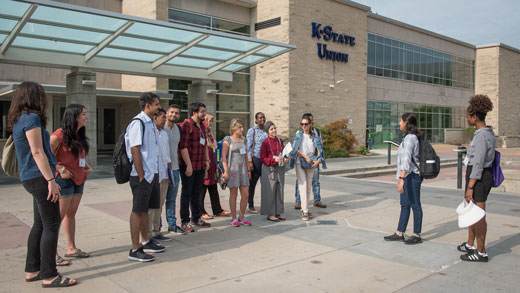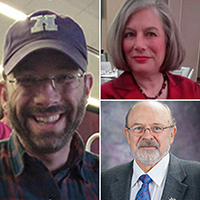07/25/18
K-State Current - July 25, 2018
K-State Current is a weekly news update for the Kansas Board of Regents to apprise the Regents on a few of the many successes and achievements made by K-State faculty, staff and students.

K-State News
K-State researchers help discover unique antibody effect with Zika and dengue viruses
Antibodies are supposed to help the body fight infection and reinfection by viruses, but new research suggests that the antibodies we produce to fight two mosquito-borne viruses may worsen — rather than guard against — reinfection.
Yan-Jan S. Huang, Dana Vanlandingham and Stephen Higgs from the diagnostic medicine and pathobiology department in the Kansas State University College of Veterinary Medicine and the Biosecurity Research Institute co-authored the paper with Joseph Mattapallil, associate professor of microbiology, and William Valiant, doctoral student, from Uniformed Services University and others from the Department of Defense and industry partner Bioqual. The paper was published on July 13 in Emerging Microbes & Infections, a Nature publication.
Dengue viruses infect millions of people a year in tropical areas such as Latin America, Southeast Asia and the Pacific Islands. The mosquito-borne virus causes dengue fever, which can develop into a fatal hemorrhagic disease. The virus comes in four closely related varieties, and when people are infected the first time, they develop antibodies that guard against reinfection with the same variety. Infection with a different variety, however, could be worsened because the antibodies that helped the first time bind poorly to the slightly different virus and help deliver it to other areas of the body.
Zika and dengue are closely related, so scientists are interested in finding out whether Zika antibodies will also be "cross-reactive" and help enhance dengue virus infections, and vice versa.
According to Stephen Higgs, director of the Biosecurity Research Institute and university distinguished professor of diagnostic medicine and pathobiology, this research is crucial to improve knowledge related to the use of vaccines against these viruses.
"When vaccines become available and are approved, it may be advantageous to vaccinate people with vaccines for Zika and Dengue at the same time, because this could reduce the chance of enhancement," Higgs said.
Results from the study provide more information on the types of antibodies involved in enhancement, the effect of the time after initial Zika infection, and whether Zika antibodies could project against dengue virus infection enhancement.
"Research in this area is ongoing. It's going to take more studies to unravel how the two viruses' antibodies affect each other," Higgs said.
Huang, Higgs, and Vanlandingham have been collaborating with Uniformed Services University scientists for the past three years and published a seminal manuscript in Nature Scientific Reports in 2017 that for the first time demonstrated enhancement of dengue infection after infection with the Zika virus.
A few weeks before her last day as CEO and dean of the Kansas State University Polytechnic Campus, Verna Fitzsimmons unveiled a new addition to the school that she hopes students, faculty and staff will use to capture some of their campus memories.
Fitzsimmons has gifted Kansas State Polytechnic a sculpture, titled "Special K," that is now the centerpiece of Ballou Plaza on campus. The artwork is constructed of three curved pieces resembling the letter "K" and is painted K-State purple. Fitzsimmons first saw the piece, designed by Oklahoma artist Jim Stewart, in 2017 when it was included in Salina's Sculpture Tour. She wants its installation on campus to encourage a new tradition among Wildcats.
"I'm excited that this sculpture will now permanently reside here on campus," said Fitzsimmons at the reveal ceremony June 14. "I really hope it starts some new traditions, for students especially. During move-in day, they can stop here and take a picture in front of it to mark their first day, or after graduation, they can take pictures here to commemorate their journey on campus."
"Special K" can be seen from the main entrance into Kansas State Polytechnic, sparking the idea that the artwork also could become a campus landmark.
"I hope it becomes an iconic piece that the community recognizes as the Polytechnic Campus," Fitzsimmons said. "I want it to encourage visitors to come to campus and then while they are here, tour the rest of the property."
In May 2017, Fitzsimmons announced she would be retiring as CEO and dean of Kansas State Polytechnic at the end of the next academic year. She had served in the role since 2012. After departing at the end of June 2018, she joined Higher Education Resource Services, or HERS, as president. Alysia Starkey, associate dean of academics and acting director of professional education and outreach at Kansas State Polytechnic, began serving as interim CEO and dean on July 1.
When posting photos with "Special K" on social media, make sure to use the hashtag #capturethek.
Fulbright foreign scholars on campus for English, cultural immersion program
 Kansas State University is hosting 32 Fulbright foreign scholars in a three-week Fulbright English for Graduate Studies program July 14-Aug. 4. The university is one of nine selected nationally to host and implement the summer 2018 program.
Kansas State University is hosting 32 Fulbright foreign scholars in a three-week Fulbright English for Graduate Studies program July 14-Aug. 4. The university is one of nine selected nationally to host and implement the summer 2018 program.
The program is sponsored by the U.S. Department of State's Bureau of Cultural Affairs and administered by the Institute of International Education in coordination with the university's English Language Program to immerse international students into the American culture.
"This Fulbright program is bringing international students to the U.S. and they will be enrolled in graduate programs all over the United States and in a variety of fields," said Ketty Reppert, English Language Program associate director of academics at Kansas State University. "Before they begin, the group will have three weeks of English and cultural orientation."
In addition to learning about the culture, the students will hone English language and academic skills, network and identify resources available for a successful transition to their graduate program.
"They will be in classes where they get some English practice as well as learn about the American education system and how a U.S. university might be different from their previous educational experiences," Reppert said
Along with structured learning, numerous opportunities are planned for the students to interact with current Kansas State University graduate students, campus resources and the local culture. The Fulbright students are also paired with volunteer community members, called Friendship Families. The Friendship Families host the visiting students for a meal or an afternoon on two separate occasions for a personal cultural experience.
"We are excited to welcome these scholars from around the world and to be their introduction to the United States," Reppert said.
The scholars represent 19 different countries in a variety of fields of study. Two of the students will begin graduate studies at Kansas State University in August.
K-State Faculty Highlights
K-State faculty present research at NOAA workshop
Drought, dams and denial were among the topics presented June 18-20 in Boulder, Colorado, by three Kansas State University faculty at a workshop sponsored by the National Oceanic and Atmospheric Administration and University of Colorado's Center for the American West.
James Sherow, university distinguished professor of history; Matthew Sanderson, Randall C. Hill distinguished professor of sociology; and Bonnie Lynn-Sherow, associate professor and director of the Chapman Center for Rural Studies, were asked by NOAA chief scientist Roger Pulwarty to share their research related to community members' responses to drought in the American West.
Thirty distinguished scholars from Kansas, Colorado, Utah, California, Nevada and New Mexico were invited to engage with one another in a deep discussion designed "to refresh our thinking, and break the power of conventional thinking in solving the difficult problems that drought creates."
Drought has become a persistent feature of life in the West, and the lessons of historians, social scientists and legal scholars who study human-environment relationships past and present are important for scientists and policymakers to grasp. As historian and Center for the American West director Patty Limerick noted, "In the United States and in many other areas of the planet, efforts to resolve conflicts or address problems (such as drought) seem destined to fail in the absence of an understanding of the origins of those conflicts and problems."
Sanderson told the group his aim is developing more sustainable, socially and ecologically resilient communities. He has been working on several projects in western Kansas that examine co-evolving relations between humans and ecosystems, focusing on the dynamic intersections of water, agriculture and local social structures in the context of long-term, global social change. His work reveals the conflicting values and realities of how western farmers and ranchers think about and therefore treat water resources, especially the Ogallala Aquifer.
Sherow, expanding on Sanderson's insights, made connections between drought and the way our western market culture reduces water to a commodity.
"Drought is a human construction, rather than a natural phenomenon, masking a failure to adjust cultural values to the ecological realities of the region," Sherow said. "Today in western Kansas, rising concerns over drought and the depletion of the Ogallala Aquifer have led to further calls to dominate nature as opposed to residents questioning how their values relate to the ecological and water realities of the region."
In the past, farmers and ranchers have attempted to adjust to new ecological realities by adopting new water saving and water storing technologies such as dams, center pivot irrigation and drought-resistant crops. Lynn-Sherow noted in her presentation that dams were promoted by the federal government as water storage solutions, but as the lifespans of many of these dams reach their endpoint, many rural residents are questioning their usefulness. For condemned communities in the path of massive dam projects in the 1950s and 60s, resistance to the dams seemed futile. This was true for Broughton, Kansas — Milford Dam — and Waconda Springs — Glen Elder Dam. But at Cedar Point, in Chase County, local resistance, led by rancher Pat Sauble, prevailed and a planned dam project that would have destroyed one of the most scenic and ecologically fragile portions of the Flint Hills was not constructed. How the residents of this small valley were able to deflect the Army Corps of Engineers is a story worth recalling today.
Pulwarty, chief scientist for drought at NOAA, has been leading workshops nationally to review and discuss the origins of several of our most persistent or wicked environmental problems, including mining, energy, air quality, water and climate change. Insights collected by NOAA at scholar workshops are frequently incorporated into policy recommendations for Congressional committees and federal agencies. A summary and transcripts of the drought workshop will be posted to the NOAA website in August.
K-State Student News
Architecture, Planning & Design students' furniture designs commercialized, win top awards
A 2017 collaboration between OFS Brands and the College of Architecture, Planning & Design, or APDesign, has paid off for students and the university.
Two projects created in an interior architecture and product design course taught by associate professor Neal Hubbell have been brought to market by OFS Brands. The final production of the students' designs were first showcased to the public in June 2018 at NeoCon — an international commercial design exhibition hosted in Chicago. Both projects took home major awards.
Roo and Lotiv, the furniture pieces developed by students, were designed during the course of two semesters in which they researched a void in the commercial furniture marketplace and created a design solution. They worked with the design team at OFS Brands to develop their ideas further before becoming part of the company's product collection. OFS Brands is a furniture manufacturer based in Huntingburg, Indiana.
The relationship between OFS Brands and Kansas State University has been beneficial for both groups.
"We continue to be impressed by the expert research, design process and raw creativity that the interior architecture and product design students and faculty bring each new year of collaboration," said Doug Shapiro, regional vice president of OFS Brands.
Roo, designed by recent Master of Interior Architecture and Product Design graduates Chelsea Flickinger and Garrett Steinlage, is an occasional table with a contemporary and modern aesthetic. It was awarded the Best of NeoCon Silver Award and a 2018 honorable mention HiP Award in the workplace: side table category.
APDesign also was represented by Lotiv, an easy-to-use pull up table designed by recent Master of Interior Architecture and Product Design graduates Katherine Arndt and Christopher Garcia. It was developed to be a flexible and convenient workspace that is easily adaptable for any work setting. Lotiv was selected as winner in the workplace: side table category for the HiP awards.
HiP awards are given by Interior Design, a design publication and website that focuses on interior design and architecture, during NeoCon. These awards are distributed to innovative designers and products in the commercial design industry.
Students' furniture pieces were shown among the commercial design industry's major manufacturers and designers at NeoCon. In addition to the notoriety of winning awards among leading designers, students and the interior architecture and product design department will receive royalties from Roo and Lotiv as they are sold by OFS Brands.
The department continues to support this collaboration with new students participating each year in the production for the contract market class that partners with OFS Brands.
"This collaboration combines a company that believes in bringing great design to the market place and talented faculty and students together to produce extraordinary work," said Nathan Howe, department head of interior architecture & product design. "There is no better combination, and I am excited to see what this partnership produces in the future."